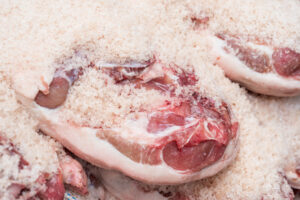
Introduction
Preserving with salt as been fundamental in food preservation for thousands of years, dating back to ancient civilizations. It was highly valued by the Egyptians, Romans, and Greeks for its ability to extend the shelf life of foods, particularly meat and fish, and eventually became a symbol of wealth and power. Salting food draws out moisture through osmosis, creating an environment that is inhospitable to bacteria, the primary cause of food spoilage. This process not only ensures the safety and longevity of the food, but also can enhance its flavor. This robust functionality of salt has made it a mainstay in food preservation techniques throughout history and across cultures.
Preserving with salt/Salt preservation
The importance of salt in food preservation cannot be overstated. Its primary role is to inhibit the growth of microorganisms by drawing water out of microbial cells through osmosis. This dehydration process creates an environment in which bacteria, molds, and yeasts are unable to grow, effectively preventing the spoilage and decay of food. Additionally, salt can enhance the taste of preserved foods, adding depth and complexity to their flavor profiles. Many traditional preservation methods, such as curing and pickling, rely heavily on salt. Moreover, the ability of salt to preserve food was a revolutionary development for early societies, enabling them to store food for lean times and travel long distances. Even today, in the era of refrigeration and canning technologies, salting remains a popular and effective method of food preservation.
How Salt Preserves Food
Osmosis plays a critical role in the preservation process, particularly in the context of salt preservation. It is a natural phenomenon where water molecules move from an area of lower salt concentration to one of higher salt concentration, aiming to achieve a state of equilibrium. When food is coated in salt, the high salt concentration outside the food compels the water within the food to move out. This outward movement of water leaves the interior of the food dehydrated, forming an environment that’s inhospitable to bacteria, molds, and yeasts. These microorganisms, which are primarily responsible for food spoilage, need moisture to survive and multiply. By depriving them of this essential resource, osmosis effectively halts their growth, preserving the food for extended periods. Thus, osmosis is a fundamental biological process that underpins the effectiveness of salt as a preserving agent.
Salt has a profound effect on bacteria and other microorganisms, largely due to its dehydration properties. In a high-salt environment, most bacteria cannot maintain the necessary fluid balance for their survival. This is because the high concentration of salt creates a hypertonic environment that causes water inside the bacteria to flow out through the cell membrane in an attempt to balance the concentration of solutes, a process known as osmosis. As a result, the bacteria dehydrate and eventually die. This is why salt is a potent weapon in the fight against many types of pathogenic bacteria, which are the prime culprits in food spoilage. However, it’s worth noting that not all microorganisms are equally susceptible to salt. Some, like the bacteria used in fermenting foods, can tolerate and even thrive in salty conditions. Therefore, while salt is a formidable preservative, its effectiveness can vary depending on the specific types of microorganisms present.
Types of Salt Preservation
Dry Salting
Dry salting, also known as curing, is a preservation method that involves applying salt directly to the food. This method typically requires large quantities of salt, which are rubbed onto the surface of the food, covering every nook and cranny. The salt draws out moisture through the process of osmosis, creating an environment that is unfavorable to the survival and growth of spoilage microorganisms. Dry salting is commonly used in the preservation of meats and fish, resulting in dehydrated, yet flavorful products such as prosciutto, salt cod, and country ham. The process is time-consuming, as the salted food must be left to cure over a period of weeks or even months. However, the end result is a long-lasting, preserved food that has a unique, intensified flavor.
Wet Salting
Wet salting, also known as brining, is another method of food preservation that involves immersing the food in a solution of salt and water, commonly referred to as brine. Unlike dry salting, brining does not dehydrate the food. Instead, it changes the osmotic pressure in the cell environment, making it inhospitable for bacteria that cause food spoilage. The food absorbs the brine, becoming saltier and gaining additional flavors if herbs and spices are added to the brine. This method is commonly employed in the preservation of vegetables, cheeses, and meats. For instance, traditional pickles are made using a brining process, as are many types of cheese like feta. Additionally, brining is often used in preparing poultry, particularly turkey, because it helps to keep the meat moist and tender during cooking. The length of the brining process can vary, from a few hours for small pieces of poultry to several days for large roasts or whole birds.
Foods Commonly Preserved with Salt
Meats and Seafood
Salt has been a primary method for preserving meats and seafood for centuries. Dry salting is often used for meats like hams and prosciutto, drying them and intensifying their flavors over a period of weeks or months. Seafood, such as cod, is also preserved in this manner, resulting in a product like salt cod that is rehydrated and cooked in various dishes. The wet salting or brining method is also popular for seafood, including shrimp and salmon, where salt water solution enhances flavor while ensuring the product’s longevity.
Vegetables
Vegetables are commonly preserved using the wet salting or brining method. The pickling process, for instance, involves immersing vegetables like cucumbers, cabbage, and carrots in a brine, often with added vinegar, spices, and herbs to enhance flavor. This method results in long-lasting, flavorful pickles that can be enjoyed year-round. Other vegetables like olives are often cured with dry salt before being transferred to a brine solution, resulting in a product with a unique, intense flavor.
Benefits of Salt Preservation
Salt preservation offers numerous advantages, particularly in terms of extending the shelf life of food. This method of food preservation inhibits the growth of bacteria, yeasts, and molds that can cause food spoilage, allowing for long-term storage and reducing food waste. Moreover, salt enhances the flavor of the food, introducing a depth and complexity that is often appreciated in cured meats, pickled vegetables, and brined seafood.
Drawbacks of Salt Preservation
However, salt preservation also comes with its own set of drawbacks. The high salt content of preserved foods can contribute to health issues if consumed in large quantities, including high blood pressure and heart disease. Moreover, the texture of salt-preserved foods can be significantly different from their fresh counterparts, which may not be preferred by all consumers. Some may also find preserved foods overly salty, detracting from the enjoyment of other flavors in the food.
Health Concerns Related to Excessive Salt Consumption
Excessive salt consumption is linked to several health issues, the most prominent among them being hypertension, or high blood pressure. Hypertension increases the risk of heart disease and stroke, two of the leading causes of death globally. Additionally, high salt intake can lead to kidney disease by putting a strain on the kidneys, impairing their ability to remove water from the body. This strain on the kidneys can result in kidney stones and ultimately kidney failure. It’s also worth noting that elevated sodium levels can cause water retention, leading to bloating and swelling. Furthermore, some studies suggest a correlation between high salt intake and stomach cancer, though more research is needed to conclusively establish this link. Given these risks, it’s crucial to monitor and moderate salt consumption, particularly when consuming preserved foods.
Conclusion: The Enduring Relevance of Salt in Food Preservation and Health Considerations
Despite the health risks associated with excessive salt consumption, the enduring relevance of salt in food preservation cannot be overlooked. Salt continues to be a vital tool in human culinary practices, preserving food, enhancing flavor, and even contributing to certain unique textures. However, the balance between the benefits of food preservation and health considerations is delicate and requires careful navigation. It’s essential to recognize the potential health implications of high sodium intake and to incorporate preserved foods into a balanced, nutritious diet in a responsible way. Moderation, as with many aspects of diet and health, appears to be the key. Salt-preserved foods can have a place in our diet, but they should not dominate it, to avoid the health issues outlined above. Moving forward, increasing public awareness about the potential health risks of excessive salt consumption and promoting better dietary choices can go a long way towards a healthier society.


